
Lane battlers have long been a popular subset of two-player games, forcing players to split attention and resources between multiple conflicts. Siege Command is designer Ryan Collins' entry, and it feels as though it took some inspiration from video game auto-battlers. In Siege Command, units deployed by the players will automatically march towards the opposing end of the lane unless they have access to special actions. Players can cast spells to help improve the inevitable engagements between units, but the design largely creates an interesting puzzle of pre-programmed conflicts. The base game on its own suffers from issues with the components and a lack of variety, but pairing with the expansion creates an interesting and fast-paced skirmish game.
Rules & Components
The rules are simple yet comprehensive; after reading them once, I didn't need to refer back during gameplay. The layout of the expansion rulebook is a bit odd to me—there’s an early section on each faction’s new mechanics, but then later, each faction has its own section for the terrain and units they use. Since none of these mechanics are used by other factions so far, I’m not sure why the mechanics were listed separately. I didn't encounter any issues learning the more advanced mechanics, but reading the expansion rules did require flipping back and forth a bit, and they can be annoying to reference later.
The cards themselves are good quality, though I do wish they had more information on them. Unit cards show their cost and various stats, but most units have a special ability which requires players to check their reference cards to know the effects. These effects aren't very complex, and I would have much preferred if the units had at least some iconography on them to indicate what they're capable of. This isn't as problematic with the base game mirror-match, but when introducing expansions, the constant reference-checking can feel cumbersome. Even more egregious are the spell cards, which only have a cost and name over the art. The game would feel significantly smoother if the cards presented players with all the information, rather than relying on references.
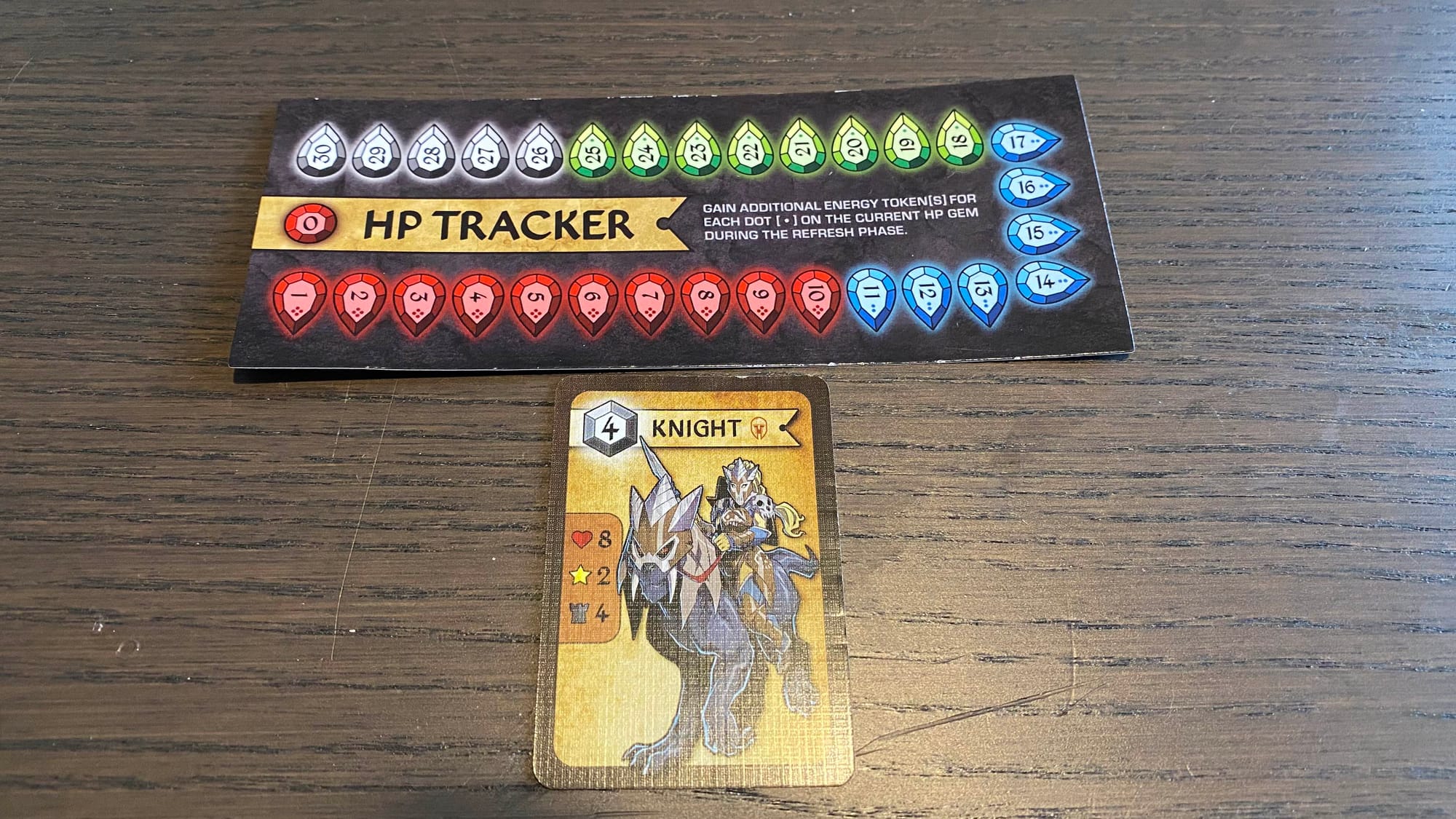
During the game, wounds and armor on units, as well as damage to the players themselves, are all tracked with small plastic clips that slide onto the cards. In theory, this is a great idea as it makes the cards easy to pick up and move across the field without needing to balance a pile of cubes or tokens on them. In practice, though, the clips are just too tight to be usable. It takes deliberate attention to align the clips and not just mash the card edges, which is more disruptive to the game's flow than dropping some cubes or tokens would be. Additionally, the clips are so tight that they actually crimp the edges of the cards and damage the player's health tracks. After the first game or two, I just started placing them on the cards instead, like tokens, for these reasons. The idea behind these clips is valid and makes sense for this game. But unfortunately, the components chosen are far more trouble than they’re worth.
Typically, I've found that starter sets for similar games have a small, non-committal box with a larger storage solution released later (such as Summoner Wars' "Master Set"). Siege Command instead presents a full-sized box with an insert to store all the content players will hopefully collect. However, the base game only includes two mini-decks, one set of landscape/turret cards, and a few other miscellaneous bits. This leaves a *very* empty box that takes up much more space than needed, at least initially. The insert would allow players to easily store any expansions and all components without issue, though the player health tracks don't have any obvious place—I opted to slot mine between the insert and the box itself. Aside from these trackers, two players’ worth of components would actually fit into a typical deckbox and make for a fairly portable skirmish game.
Base Gameplay
In Siege Command, players send their units down multiple lanes towards each other, taking control of Turrets and breaching the opposing edge of the field to deal damage and reduce the opponent's health, or HP, to 0. Most of the decisions occur during the Planning Phase, where units and spells are played face down simultaneously to essentially program for the upcoming Action Phase. Players choose a unit from their hand to add to each lane, with "Bluffs" available to keep your opponent from seeing your plans. Spells are played similarly, but don't need to be assigned to a lane nor have decoys available. Once both players are ready, the Reveal Phase begins by revealing the facedown cards and paying their costs, or discarding them if players are unable to afford them. Then, the players enter the Action Phase and alternate either activating a unit or resolving a played spell.
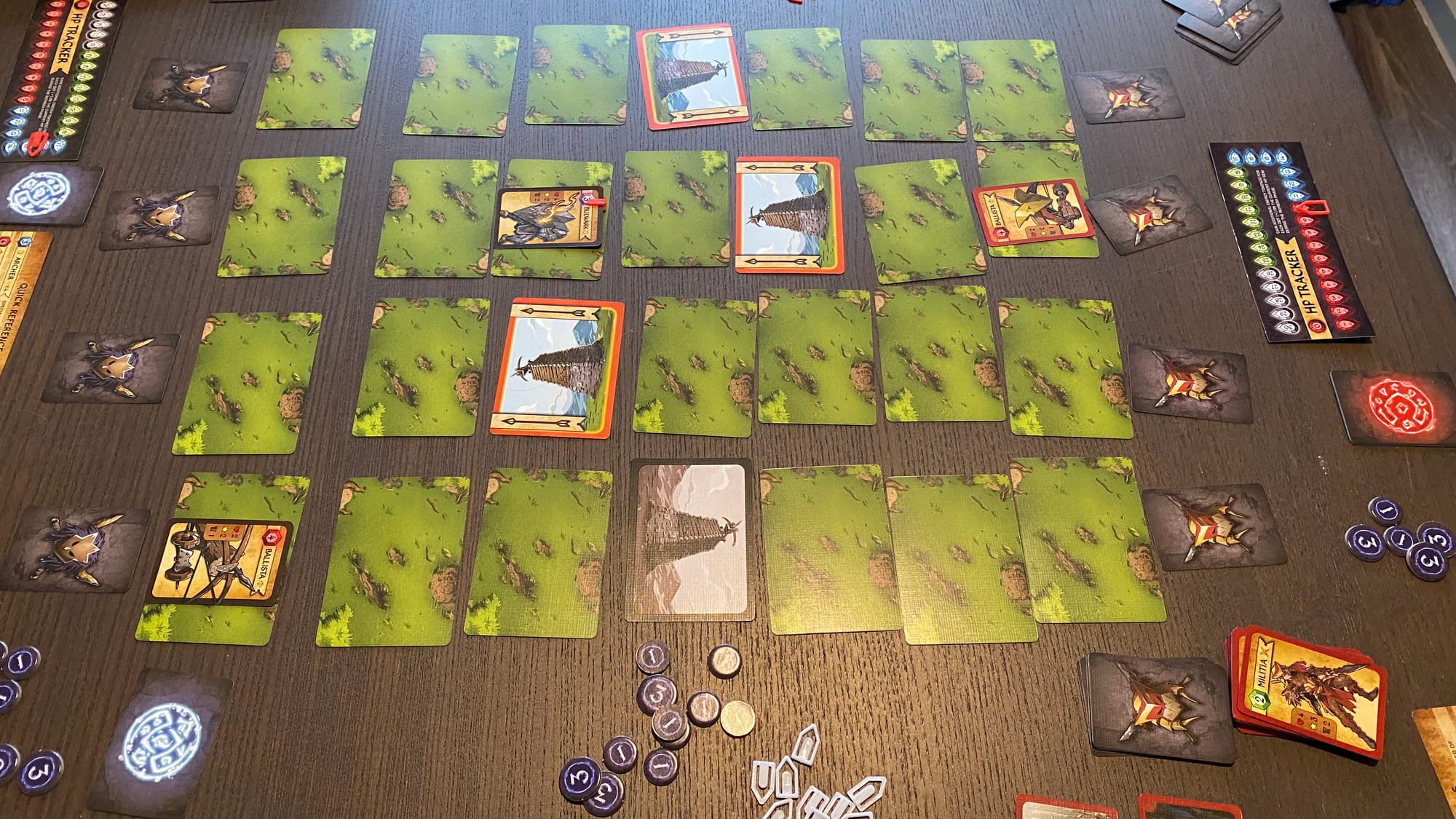
Units have action points to dictate how much they can do when activated. Some units have special abilities, but most are simply able to advance down their lane, battling opposing units and capturing Turrets along the way. Units must spend all their action points, so they will advance as far as possible if they don’t have any other abilities to spend them on. Each unit also has a Vitality stat, which dictates both how many wounds they can take and how much damage they currently deal, and a Siege Damage stat. When a unit reaches the end of its lane, it deals damage to the opponent’s HP equal to the unit’s Siege Damage and is removed from the board.
In addition to units’ Siege Damage, Turrets are the primary source of HP damage and make up most of the game’s tug-of-war. Turrets are part of the lanes like any other space, but once a unit moves off the Turret space, it activates under the unit owner’s control and will fire at their opponent. To neutralize a Turret, players simply move one of their units onto an enemy-controlled Turret to revert it to a neutral state. Moving their unit off the Turret will then flip it to fire under their control. At the end of each round, all activated Turrets fire simultaneously for three damage to the opposing HP. Because it can be fairly easy to stop an approaching unit from getting far enough to deal Siege Damage, these Turrets are the primary method for dealing HP damage and will be highly contested.
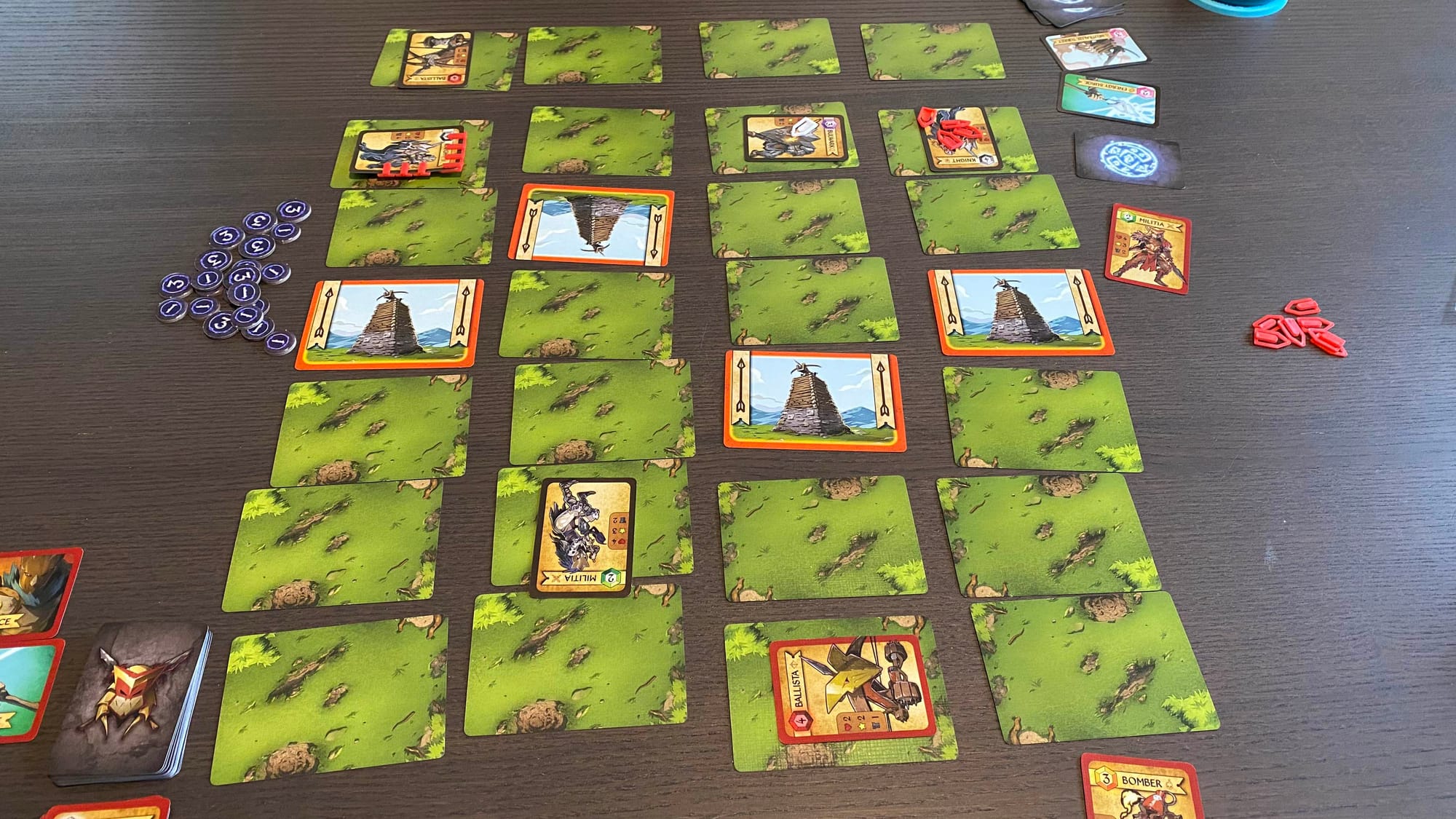
At the end of a round, if neither player’s HP has broken, players Refresh by readying their deployed units, gaining more Energy with a bonus based on having low HP, and cycling their Spells. If a Spell was used in the previous round, it enters a cooldown stack. At this point, players refill their hand of Spells by picking from two revealed from the cooldown stack, which prevents any Spell from being spammed each round. Players can also discard any units they don’t want from their hands before drawing back up.
Base Review
The gameplay loop is simple, and players can quickly grasp the flow of everything. None of the mechanics are overly complex, and there are plenty of decisions to make between unit deployments and casting Spells. Since even your hand of units and spells is pretty well controlled, there’s a surprisingly low amount of randomness in the game. There’s only been the occasional moment where I really wanted a specific unit but couldn’t draw it in time—all of my wins and losses felt like the results of my own tactical decisions rather than the whims of dice.
However, the lack of chance also prevents the game from developing any real sense of tension. Of course, there’s the brief moment between finishing my Planning and the Reveal step where I worry if the opponent had done something I hadn’t thought of or pulled off what I’d worried about. But after everything is revealed and paid for, both players simply take a few seconds to analyze the board before seeing how everything will pan out, assuming they both play optimally. Occasionally, there’ll be a minor decision like choosing which Turret to claim or which to sacrifice based on activation order, but little aside from that. This isn’t solely due to the lack of chance, but also the lack of secrets. Once the Reveal happens, both players have perfect information for the rest of the round and can play perfectly. Theoretically, someone could attempt to set up for a better play in a future round, but the loss of tempo usually gives the opponent too much of an edge to be worth it.
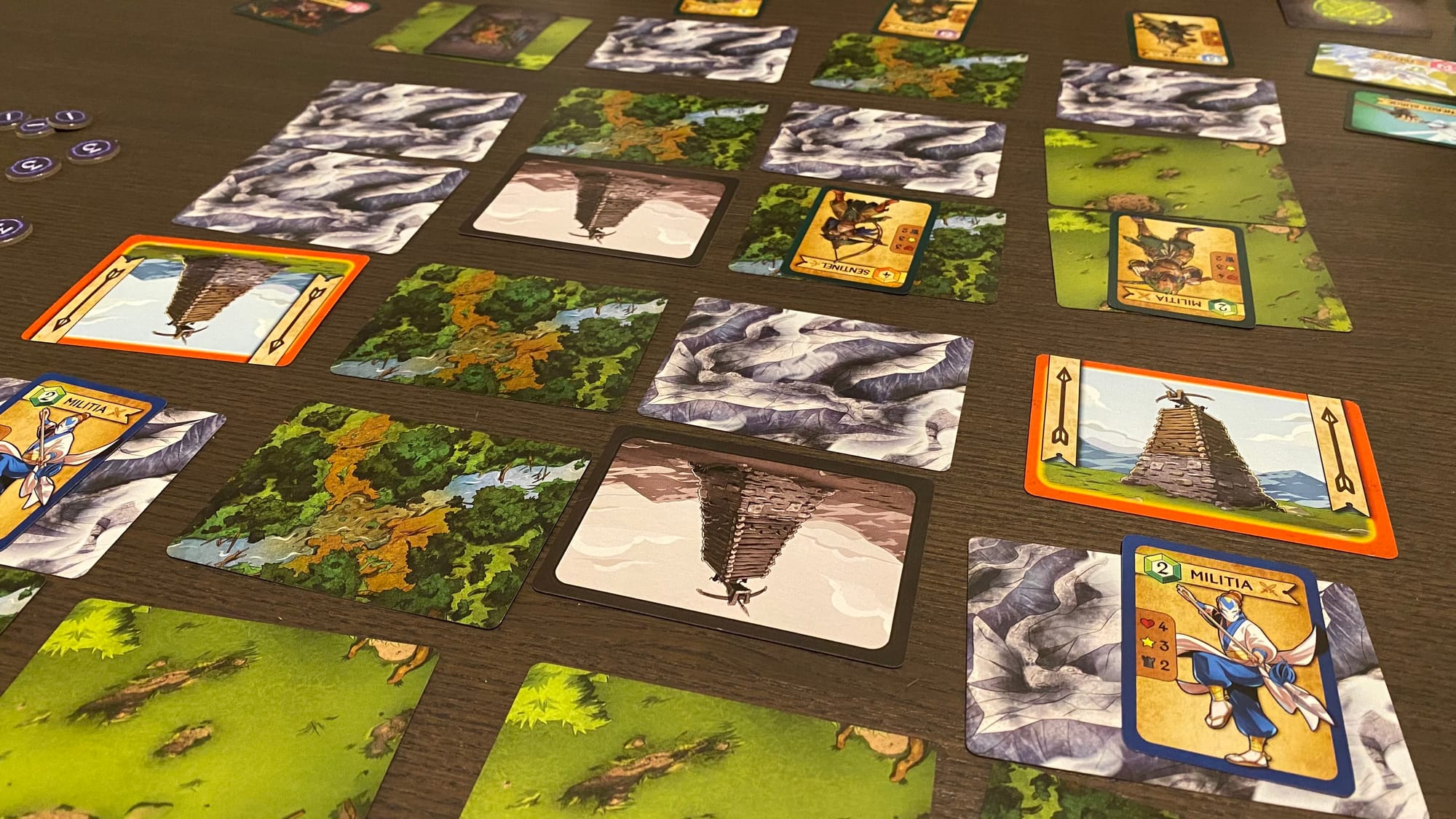
The base game comes with two Tribes (faction decks), the Tal-Renai and the Ondari. I don’t mind a lack of options, since two-faction starters are pretty standard. But these two Tribes differ in name and art only. Neither has access to anything the other doesn’t, and their unit counts are identical. I understand not wanting to overwhelm new players with too many mechanics, especially since the game’s easy teach is a strong point, but the resulting mirror matches are incredibly boring after the first game. I’ve never been a big fan of Chess, so maybe this would appeal to players who enjoy the symmetry, but to me, it creates an experience that stales quickly.
This is all an incredible shame, since the game offers quite a few tactical decisions with no truly wrong answer. Do you focus on controlling a few turrets and playing defensively while they whittle your opponent down, or do you play aggressively so your units can lay siege themselves? Focus on a couple lanes with expensive units or spread out with more of the cheap ones? Even if you choose a slower strategy and take early damage, that damage allows you to get more energy per turn than your opponent, which can turn the tide. The core game just lacks any variety outside of players experimenting with strategy.
Siege Command
Mediocre
A simple and easy to learn skirmish game with unique lane mechanics, marred by card-damaging components and gameplay that can quickly wear thin.
Pros
- Simple rules
- Lane mechanics are interesting and easy to understand
- Player decisions don’t hinge on random luck
- Multiple strategies for players to explore
Cons
- Lack of tension during the longest phase of the game
- Mirror matches dull quickly
- Components will crimp and mark cards
- Minimal variety to encourage replayability
This review is based on a retail copy provided by the publisher.
The Conclave Wars Gameplay
The first expansion to Siege Command, The Conclave Wars, adds three new Tribes, each with their own set of mechanics, units, and even terrain.
The Galan-Dar Tribe can store energy tokens on their units—via the Conduit unit’s Channel ability— which can be spent to give them extra AP while activating. Their other units provide more ranged special actions, which certainly benefit from the extra AP. New spells Shockwave, which pushes all opponents in a lane back a space, and Chain Lightning, which deals increasing damage the more opponents it hits, can make the other player more thoughtful with their unit placement.
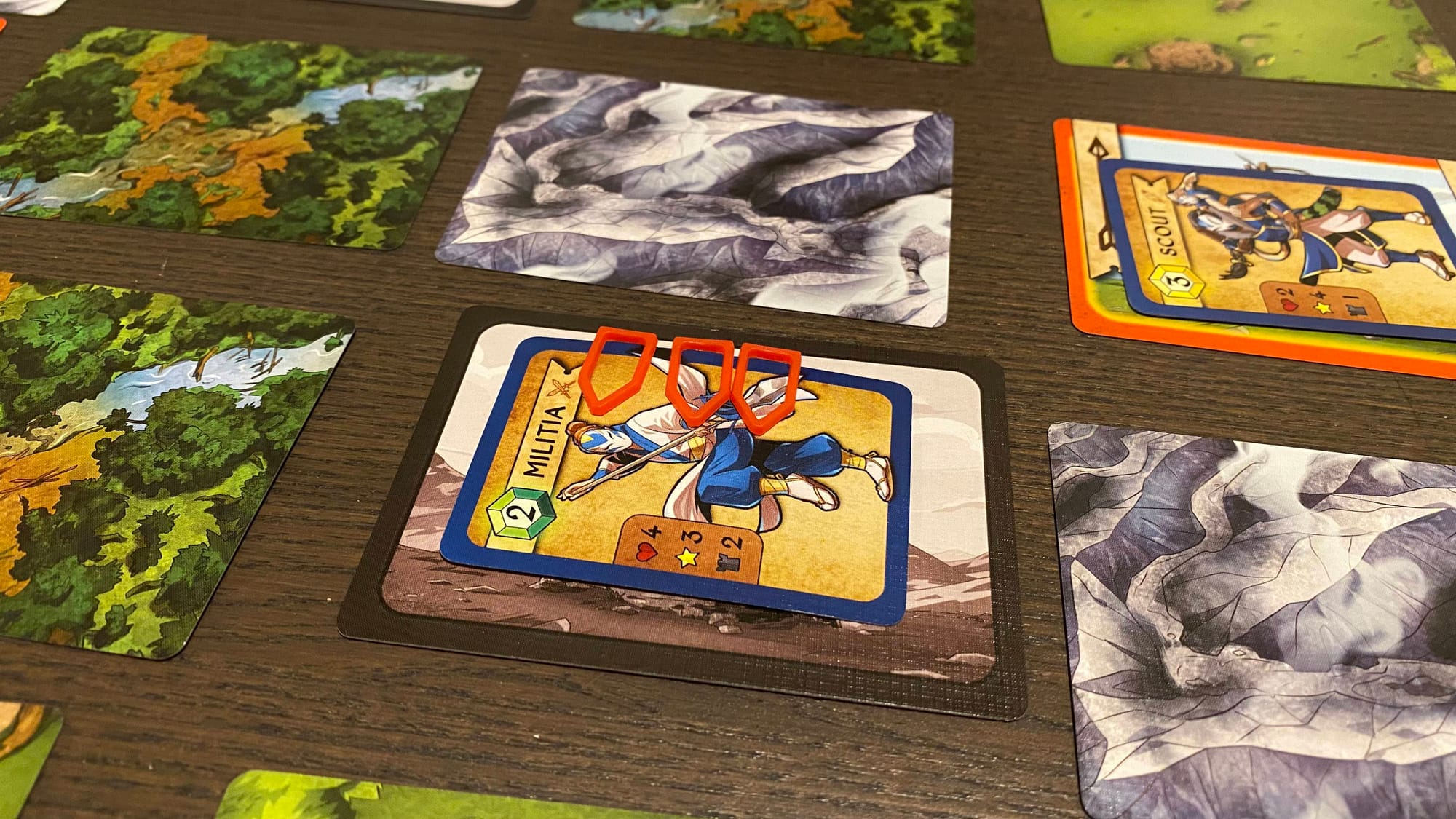
The Hekmet add tokens to the battlefield, either Barricades that cost 2 AP to remove and prevent opponents from crossing, or Traps, which inflict 1 damage to enemy units that encounter them. The Engineer and Trapper units deploy these tokens, but the real star of this faction is the Beast Tamer, which can pounce on units from a distance, dealing one damage before engaging in melee. Because attack and health are the same stat, not only is this a rather mobile unit, it also takes less damage when engaging than other units would. The Hekmet’s spells allow them to transport units across the board even faster with Tunnel, which moves a friendly unit 4 spaces, or add extra Trap tokens to the board with Surprise.
Third and most complex of the new Tribes, the Sedgekin have units with the ability to enter a Hidden state and flip face-down. Hidden units must move slowly and can’t capture Turrets, but can’t be targeted or engaged by the opponent. When the Sedgekin chooses to reveal a Hidden unit, it can sneak attack an enemy in its space, dealing 2 damage before engaging. Though their Sentinel and Stalker units don’t have very much range on their special attacks, the Sentinel can Hide, and Stalkers can sidestep into other lanes, allowing them to avoid most retaliation. The Shadow unit even Hides better than other units, moving faster while hidden and gaining access to sidestep like the Stalker. Sedgekin’s new spells all focus on this Hidden mechanic: Ambush either reveals all Hidden units (without paying the usual cost) or advances all Hidden units, Diversion lets the player get a bit tricky by secretly swapping two Hidden units (or not), and Vanish can Hide even units without the special action.
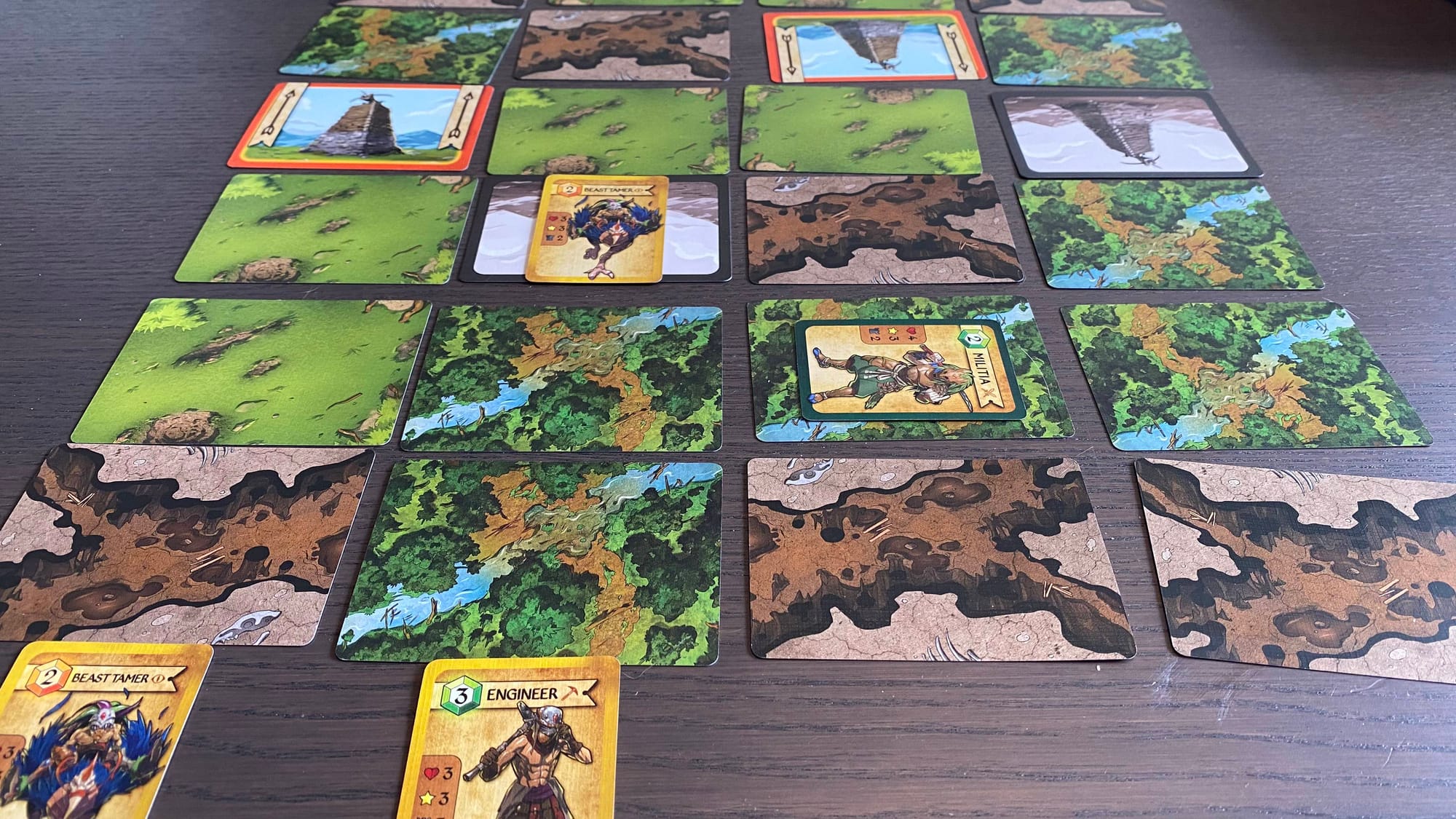
At the start of any game including these Tribes, their special terrain cards are mixed with some of the basic terrain before creating the battlefield. In addition to having an effect on all units, each Tribe gets a special bonus from its “home” terrain. The Galan-Dar’s mountains give extra energy to players when one of their units ends an activation in them, and allow any Galan-Dar units the ability to Channel. The Hekmet’s tunnels act as trenches, protecting units from spells and ranged special actions. The Hekmet can also utilize these with their Tunnel spell to teleport their units from tunnel to tunnel instead of its usual movement effect. Finally, the Sedgekin’s forest terrain provides cover even to units not in it, counting as 2 spaces when calculating spell and action ranges. For the Sedgekin, units on forest terrain instead gain +1 range on their actions.
The Conclave Wars Review
This expansion added some much-needed depth and variety to the game. The Tribes all fit the core gameplay well, and their mechanics aren’t too complex, aside from some edge cases with Hidden units. No faction feels imbalanced against each other; I couldn’t win with the Galan-Dar, but I just don’t think their playstyle suits me.
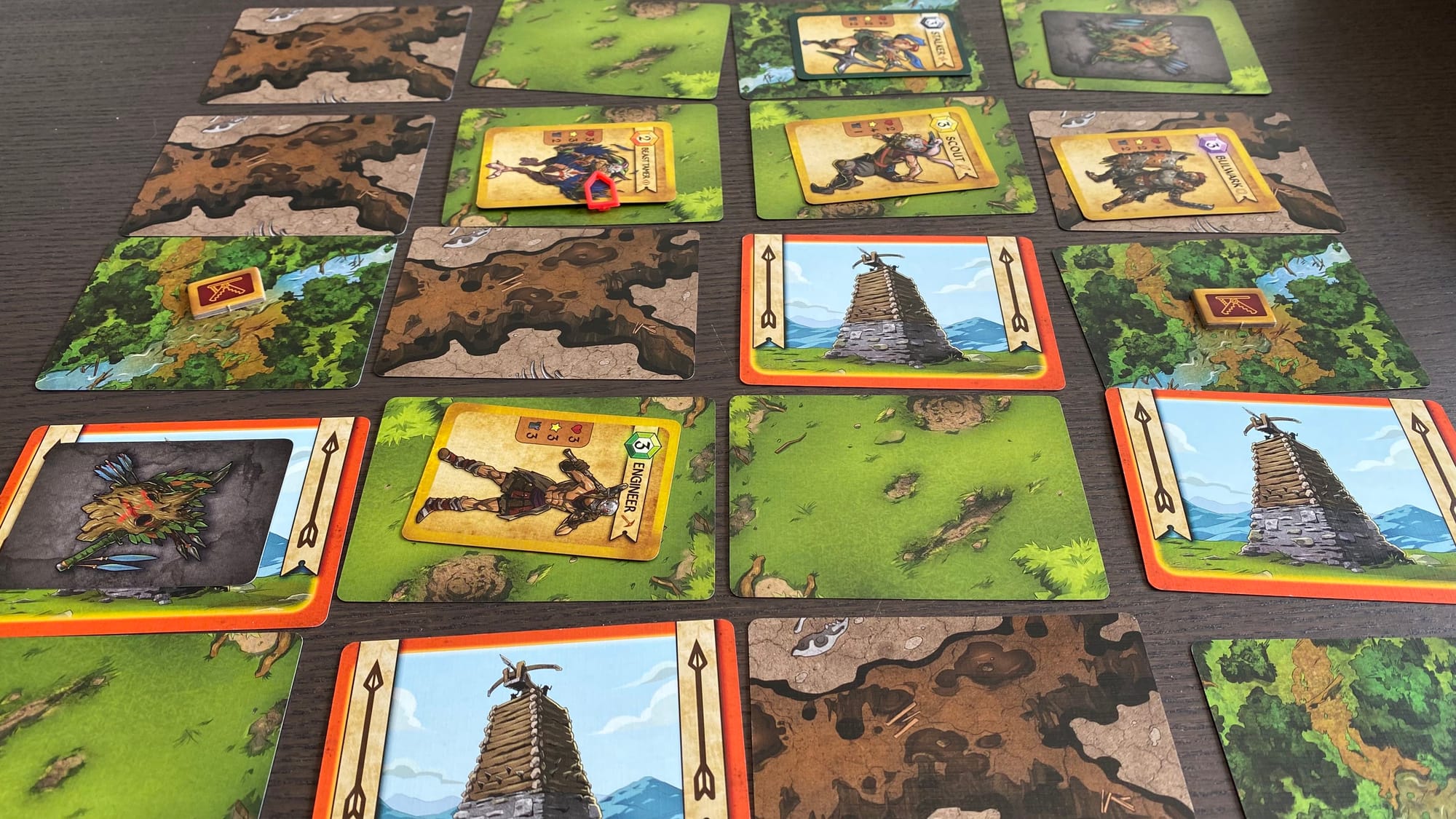
These Tribes fixed one of my main complaints with the base game, which is the lack of variation and the staleness of mirror matches. It makes the base Tribes a bit redundant though, since I can’t see why I would ever choose to play as either of them in place of the far more interesting expansion Tribes. While the base game isn’t something I would ever recommend compared to other similar games, this expansion does bring it to a level of quality that I could see myself playing even outside of review.
Unfortunately, there are some issues that the expansion still left unresolved, as they’re deeper than simply adding more content would fix. There is still no alternative to the card-crimping clips, and even though the Sedgekin’s Hidden units add a bit of uncertainty, there is largely no tension during the Action phase.
I think this is an amazing expansion for this game, and as such, would rate the expansion on its own rather highly. However, I think it’s far more valuable in this case to consider the base game and this expansion as a package. So, while the pros and cons will be solely based on the new content, the score itself will instead reflect my opinion of Siege Command + The Conclave Wars as a combined experience.
Siege Command: The Conclave Wars
Alright
This expansion added three very interesting Tribes with distinct mechanics and strategies that are all fun to play as and against. Terrain makes the map more interesting and introduces more options to gameplay. The rulebook was not organized in a way that makes immediate sense to me, but is serviceable enough.
Pros
- New Tribes mix up gameplay
- Terrain keeps the map feeling fresh
Cons
- Rulebook has an odd layout that makes referencing rules annoying
This review is based on a retail copy provided by the publisher.
